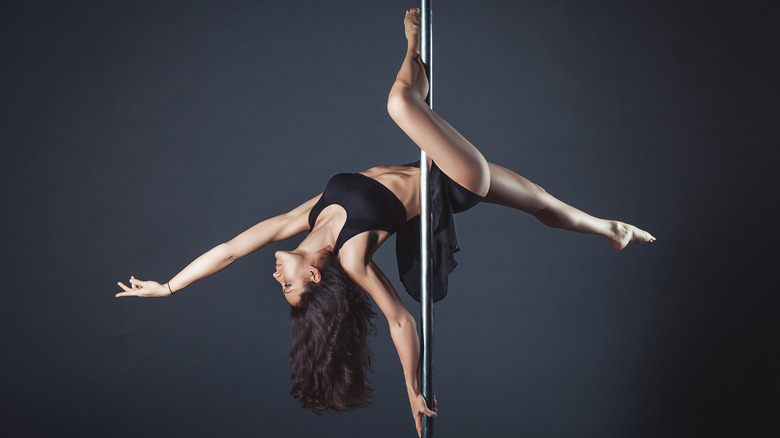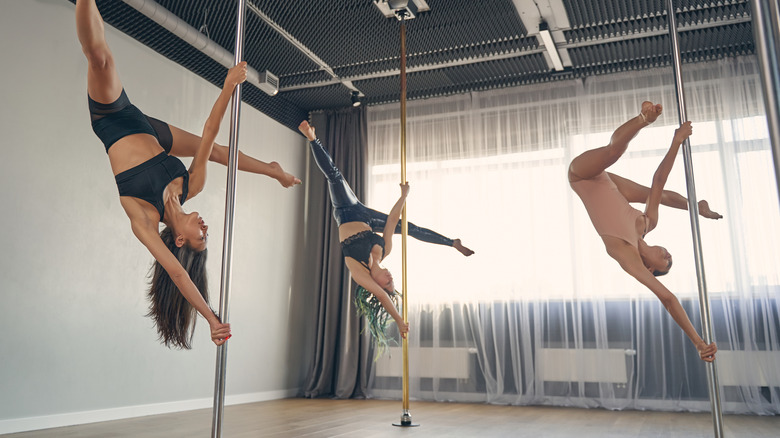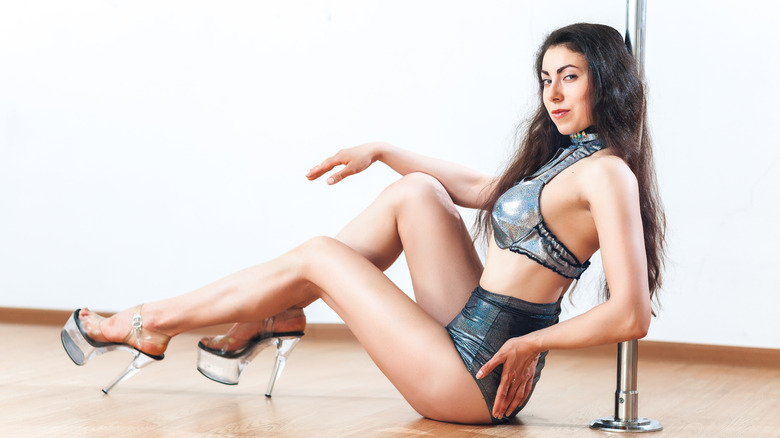What You Need To Know About Pole Dancing
In Western culture, pole dancing has long been associated with the adult entertainment industry, so you may be surprised to learn that its popularity has exceeded its strip club association in recent years, with Vogue even saying the fitness activity can be "life-changing." Now, it's not uncommon to see gym advertisements for pole dancing classes or social media posts of novice dancers showing off their new moves. You may have even read that "sMothered" duo Dawn and Cher took a pole dancing class together.
As fitness trends have a tendency to take over, pole dancing seems to be an exercise type that is here to stay. According to Pole Model, it was first taught as a fitness form in the 1990s and has since gained popularity as an exercise type, known as pole fitness, and as an art form. It isn't the first pole-centered exercise to gain mainstream popularity, though, as it has historical origins in 12th-century India (per Polepedia). As explained by Yogapedia, Mallakhamb is an Indian sport centered around a standing or hanging pole. This intense exercise consists of various wrestling grips that strengthen the muscles and aerial poses that imitate yoga positions. Although Mallakhamb is traditionally practiced by men, it has provided clear inspiration for what is known as modern pole dancing.
With this in mind, here is what you need to know about pole dancing.
Pole dancing is both an exercise and an art
If you're interested in pole dancing, then there are some basics to learn before signing up for a class. According to Mind Body Green, there are three branches of pole fitness are available to explore, with the first branch focused on the athletic side of the practice.
Pole dancing is a challenging exercise form, making it a great way for athletes to challenge themselves. As mentioned in Body Building, pole fitness combines climbing, spinning, and dancing around a pole of at least 40 milliliters. Often, this first branch of pole dancing will eliminate the dancing element to focus on aerial acrobatics. Either way, this workout, which especially involves flexibility and upper-body strength, has women of all ages raving about the physical benefits of pole fitness.
While the first branch of pole dancing is interested in the fitness elements of the sport, the second branch emphasizes the creativity of the dance element. Per Polecon International, pole dancing is just as demanding and craftable as any other type of dance, making it a great way to express different emotions through choreography, music, and sometimes even props outside of the pole.
Lastly, the third branch of pole dancing embraces the sexiness that first associated the practice with the adult entertainment industry. While this branch can vary in the erotic styles of dance practiced, Body Building explains that it is often associated with the six-to-eight inch heels known as "pleasers" that dancers wear while performing.
Pole dancing continues to be a part of feminist discussions
Even though pole dancing has grown as a mainstream form of exercise, much stigma still exists around the practice because of its association with strip clubs and adult entertainment. Additionally, feminist conversations about the nature of pole dancing continue to thrive with female debaters on either side of the argument. Some women claim a sense of sexual empowerment from pole dancing (via Body Building), while others argue that it perpetuates the sexism and objectification originally alleged against the adult entertainment industry, according to Feminist Current.
In many ways, arguments for and against pole dancing mimics the feminist divide between larger sex-positive and anti-pornography strains of feminism. These two opposing strains of feminism first arose in the second wave of the movement, which began in the 1970s, with figures like Candida Royalle and Betty Dodson campaigning for the sexual freedom of women while individuals like Andrea Dworkin and Catharine MacKinnon argued against the harmful ideals perpetuated through porn (per Pleasure Mechanics).
Despite this ongoing conversation, feminism, at its core, campaigns for a woman's right to make her own, informed decisions. In this way, it's important to know about pole dancing's background but ultimately only you (whether you identify as a woman or not) can decide if it's the right fitness form for you.


